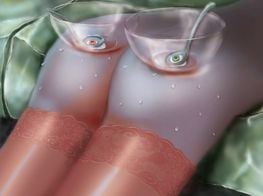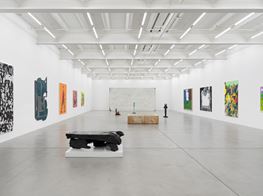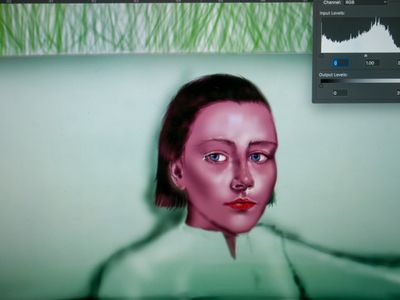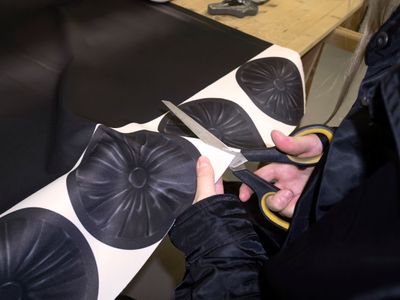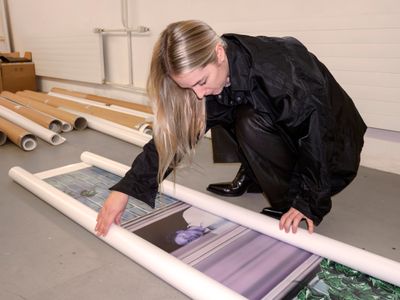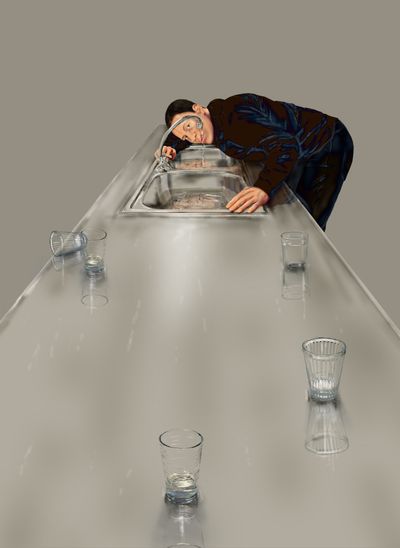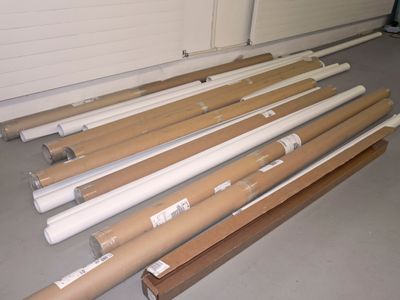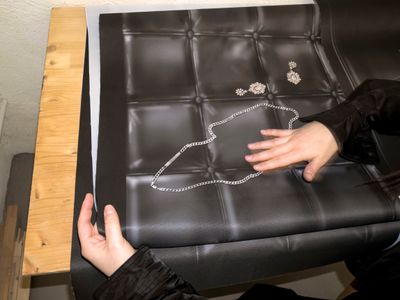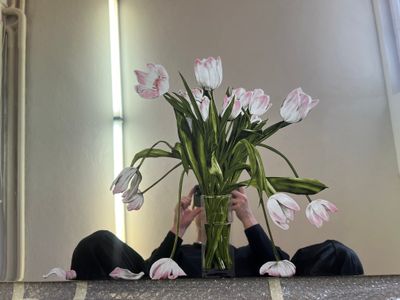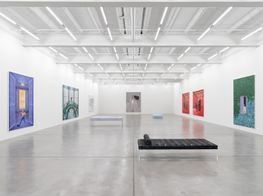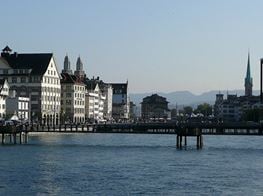
You wouldn't be the only person to walk up to a Louisa Gagliardi painting surprised to find not a drop of paint on the canvas.
Rather, the Zurich-based artist found her niche behind her computer screen, creating digitised portraits that are blown up and finished in transparent gel, toying with our sense of reality and illusion.
A year after announcing her representation, Galerie Eva Presenhuber hosts A Moment's Notice (25 March–20 May 2023), Gagliardi's first solo exhibition with the gallery, which showcases a mix of her latest paintings and sculptures in Zurich.
Ahead of the opening, Gagliardi sat down to chat about her lucky break into the art world, the dumbfounded reactions to her digitised portraits, and the Nordic light that inspired this latest body of work.
You studied graphic design, an unusual start for someone now producing predominantly figurative paintings. What led you down that path?
I've always been surrounded by art, but I grew up in quite a pragmatic environment. With my native values, I felt that I couldn't just study art.
I've always loved cinema, photography, and fashion. I felt graphic design was the common denominator that would allow me to work closely with the things I loved.
But working as an illustrator post-university, I got bored by the commission-based aspect of it.
I started to develop a new vocabulary, which turned out to be more painterly. In 2015, I released two portraits on my website that only existed as JPEGs at the time. Within a week, two galleries approached me to show those works.
This was a magical moment, as I always wanted to be an artist. But working in printmaking and 2D, I didn't think this was possible. These galleries gave me the confidence to think, 'Yeah, okay, this is art.'
How similar are the works you made in 2015 to what you're producing today?
When you're learning a new technique, faces are the easy, go-to subject. The 2015 paintings were close-up portraits of my friends and people in social gatherings, hiding behind beer cans or cigarettes, coping with social anxiety—I think the subject was already there.
Yet the aesthetic and touch are quite different. Now that I've mastered my craft a lot more, I will obsess over a cuticle on a nail, whereas before it was a lot more approximate.
Your process is part computer-based, part studio, taking digitally rendered images, painting them onto glossy vinyl, and adding a gel finish. Why this approach?
From a very young age, my mother and grandmother would take me to museums when we visited different cities. They would tell me about the paintings, and the symbols and techniques involved.
Although I went down a more digital route, I wanted my work to nod to what I call 'analogue' painting—a practice I am fascinated by and revere.
Brushstrokes make a painting come alive and I love how light interacts with a painting when experiencing it in person. When light hits too hard, it almost erases the painting altogether and you find yourself moving around the work for it to be revealed.
And how did you come upon the gel medium?
I didn't want to add paint, as I didn't know how. What I love about the gel medium is that you are able to add brush stokes without adding any form of colour. It provides the physicality of painting without altering the digital too much.
Of course, there were a lot of tests. I tried latex and smoother varnishes, but I thought the thick lathering of gel worked well.
How do people react when they see your work in person for the first time?
I think while they read quite well online, once you experience them in person, little moments occur as you walk around the painting, giving them a new dimension.
A very early conversation about the work is 'Do I frame them or not?'. For me, it was very clear that I didn't want them framed. This way, viewers could see the profile of the painting as this gives away that this is a digital work. I didn't want to 'fool' anybody.
A while back, I received an interview request and answered via email. On reading my responses, they wrote me a simple and short email saying, 'Oh, I didn't realise those weren't real paintings, so we may not go ahead with the article anymore.'
While they changed their mind, you could tell they felt fooled. It was like treason, almost like 'Oh my god'. But for me, it was this visceral 'Oh no' reaction that I love.
When you sat down to plan for this show, was there a specific idea you wanted to express with this body of work? Or was it something that developed as each work was completed?
This show came about at a perfect time as my partner and I went to do a residency in a small village in Norway.
It was the beginning of winter, and I mean, full-on winter there. The lighting was extreme, with very long shadows from morning to sunset, and the sun was only up for 30 minutes a day. I think this subconsciously influenced the lighting and settings of these works.
But coming from a commercial background, I try not to have a clear concept when I start to work as I'm afraid that I will start illustrating a topic rather than letting it take me places. Instead, every work informs the next, letting my subconscious do the work.
I read somewhere that you looked to Caravaggio for light, Lautrec for colour, and Renaissance paintings for interactions. Are there any new influences that inspired your show at Eva Presenhuber?
I think those names will always be very relevant in my work. As I never learned to paint academically, I go back and look at these painters to help me understand how to draw that eye or create that atmosphere.
There are too many to list, but I've been really obsessed with Pierre Bonnard for everything—his touch, his subjects, colours, and how he uses light, and creates frames within frames—all of it.
A more direct historical reference in the show would be the Greco-Roman sculpture, Boy with Thorn (ca. 300BC). I've always found it very beautiful. Yet there is a sadness and melancholia about it that I really love.
When reading up on the piece, I found the quote: 'He is so focused on the difficult task of not feeling the pain.'
As I talk a lot about human interaction in the era of technology and social media, I thought it was appropriate as a symbol for my paintings.
What imagery inspired these works? Are the figures a product of your imagination, or are you drawing from memories or experiences?
It's a little bit of everything.
Because of the short days, I slept a lot in Norway and had amazing, vivid dreams. I could have two or three a night that I would remember the next day, and because of the isolation, it created a really special landscape in my mind.
And so, these dreamlike places that can be everywhere and nowhere slipped into these works. I wanted my paintings to be open vessels for the viewer's imagination.
But what I've provided really is a weird patchwork of everything: cartoons, anime, and photography. A healthy mix, I would say.
Last year at Art Basel you presented a monumental work, measuring over ten metres long. What did you learn from this experience, and is scale a feature of this exhibition?
Being Swiss, I've been going to Art Basel since I was 12 years old. I always see the artists I admire most there. So of course, when I got my application accepted, I was like, 'Oh my god, it's real, I'm part of this, and I really need to do something good.'
There was definitely a fear, in terms of the sheer scale and daunting prospect of showing the work to my peers and the many visitors. But it was also a huge step forward, in the way of unlocking a fear and seeing that it was manageable.
My strongest reaction was when I first stretched one of the panels on my own in the studio. I got really emotional. Working on a computer so much, you learn to visualise your work, but the moment it becomes physical is always magical.
I've always dreamed of working this big. The space at Eva Presenhuber is very large, so it allowed me to expand and make these paintings even more immersive.
What's next for you?
Right now, I'm working on a big painting for Art Brussels [20–23 April 2023] with my gallery Rodolphe Janssen, followed by another bigger painting for Art Basel this June [15–18 June 2023]. —[O]
Main image: Courtesy Louisa Gagliardi. Photo: Adam Cruces.

